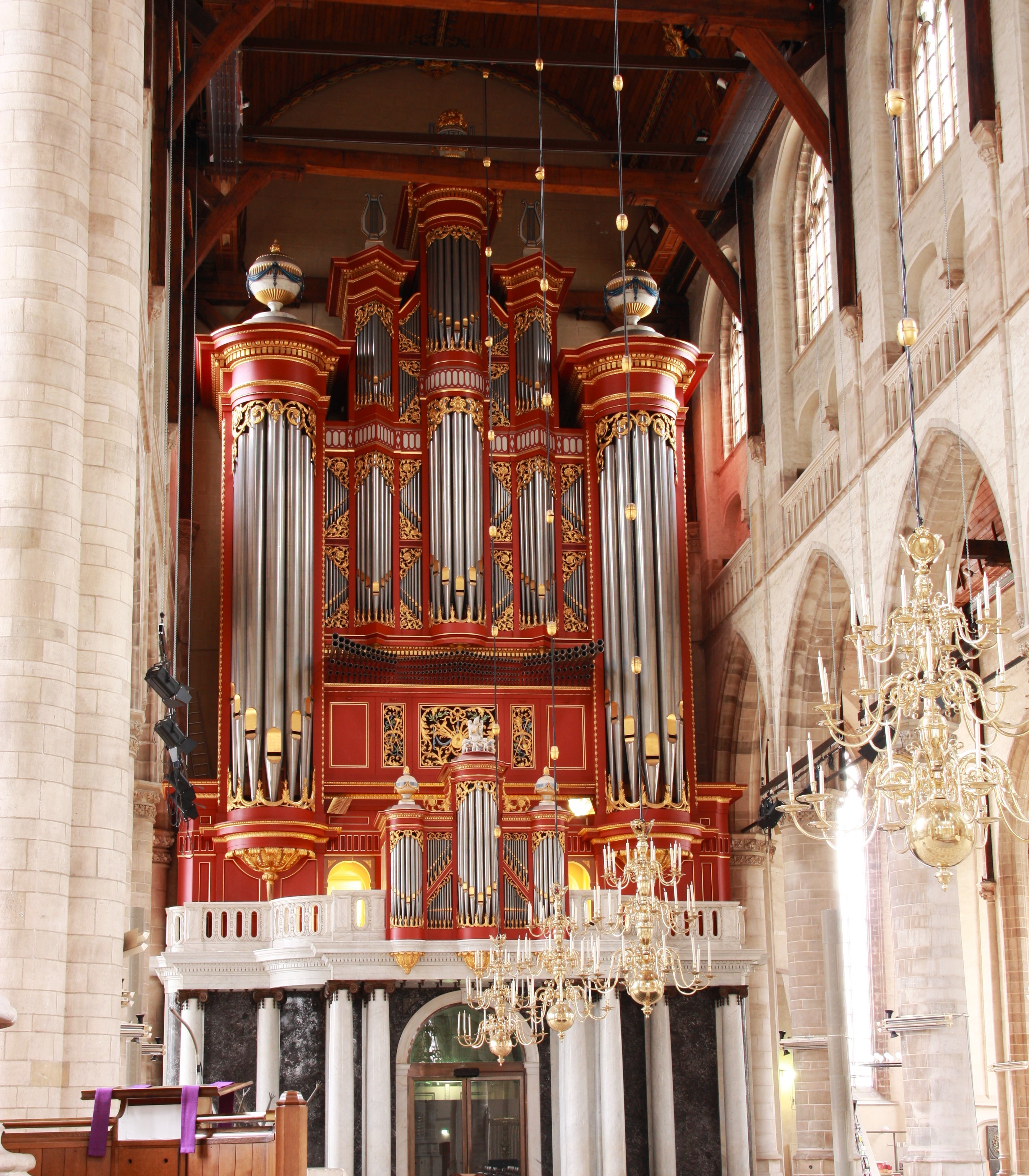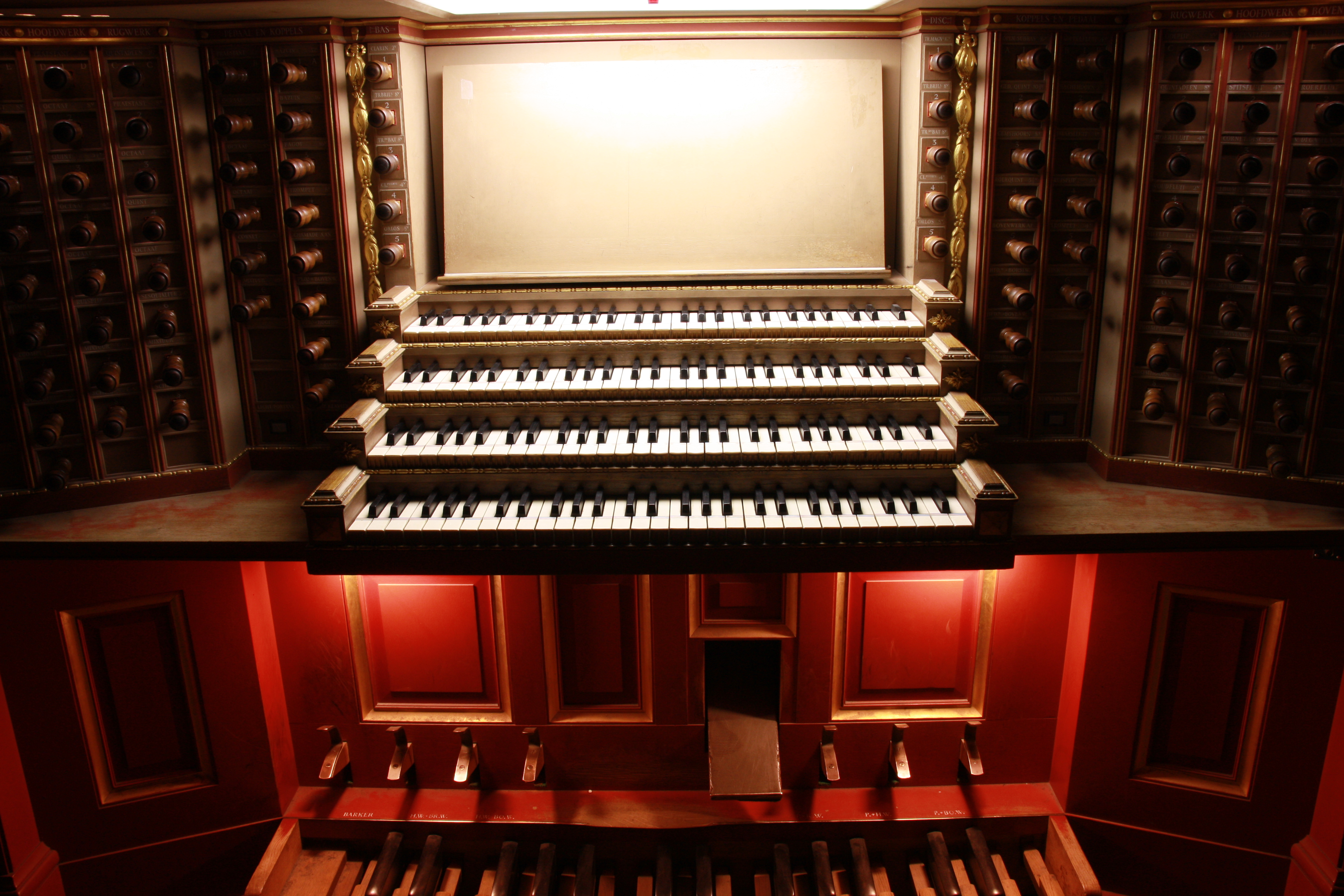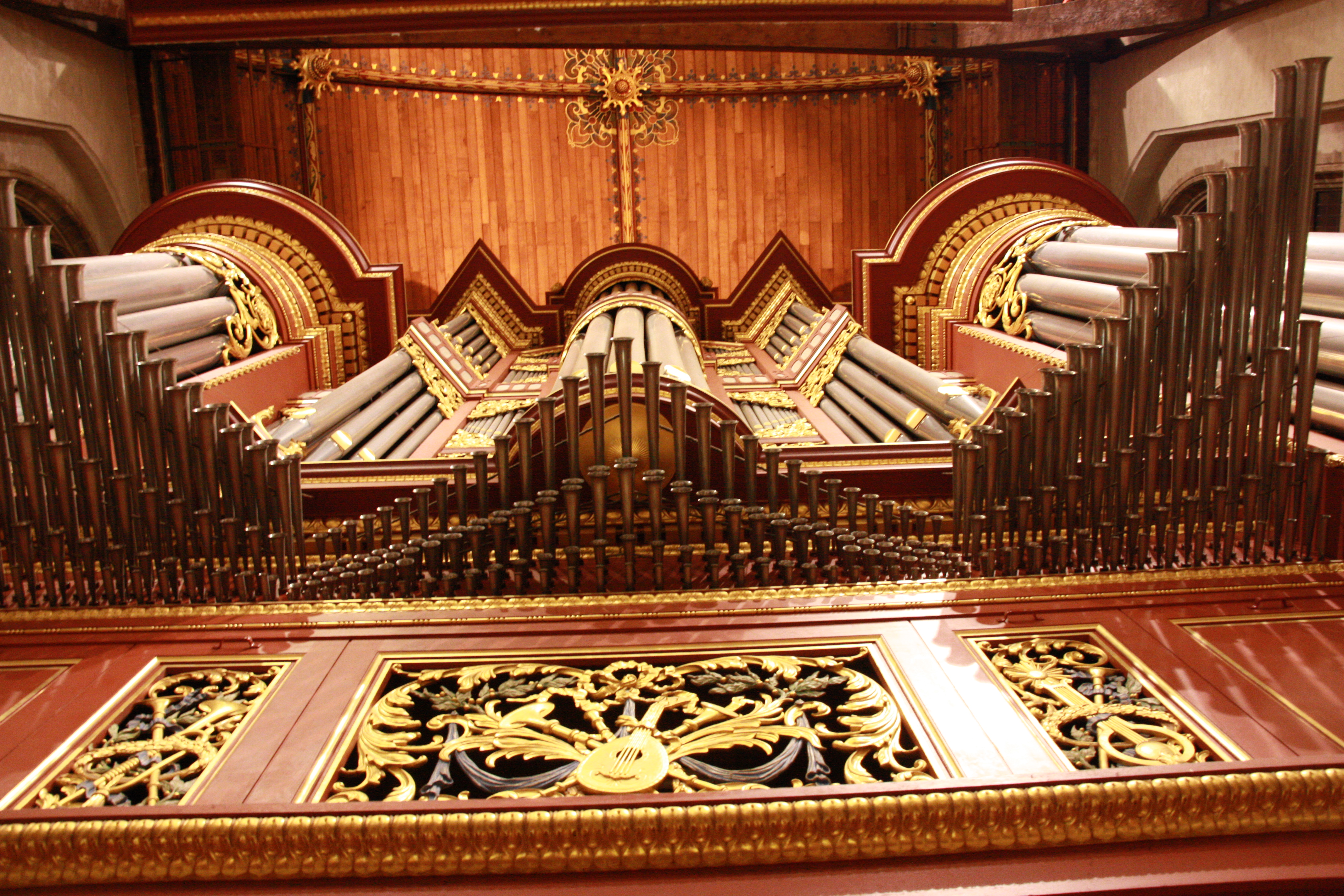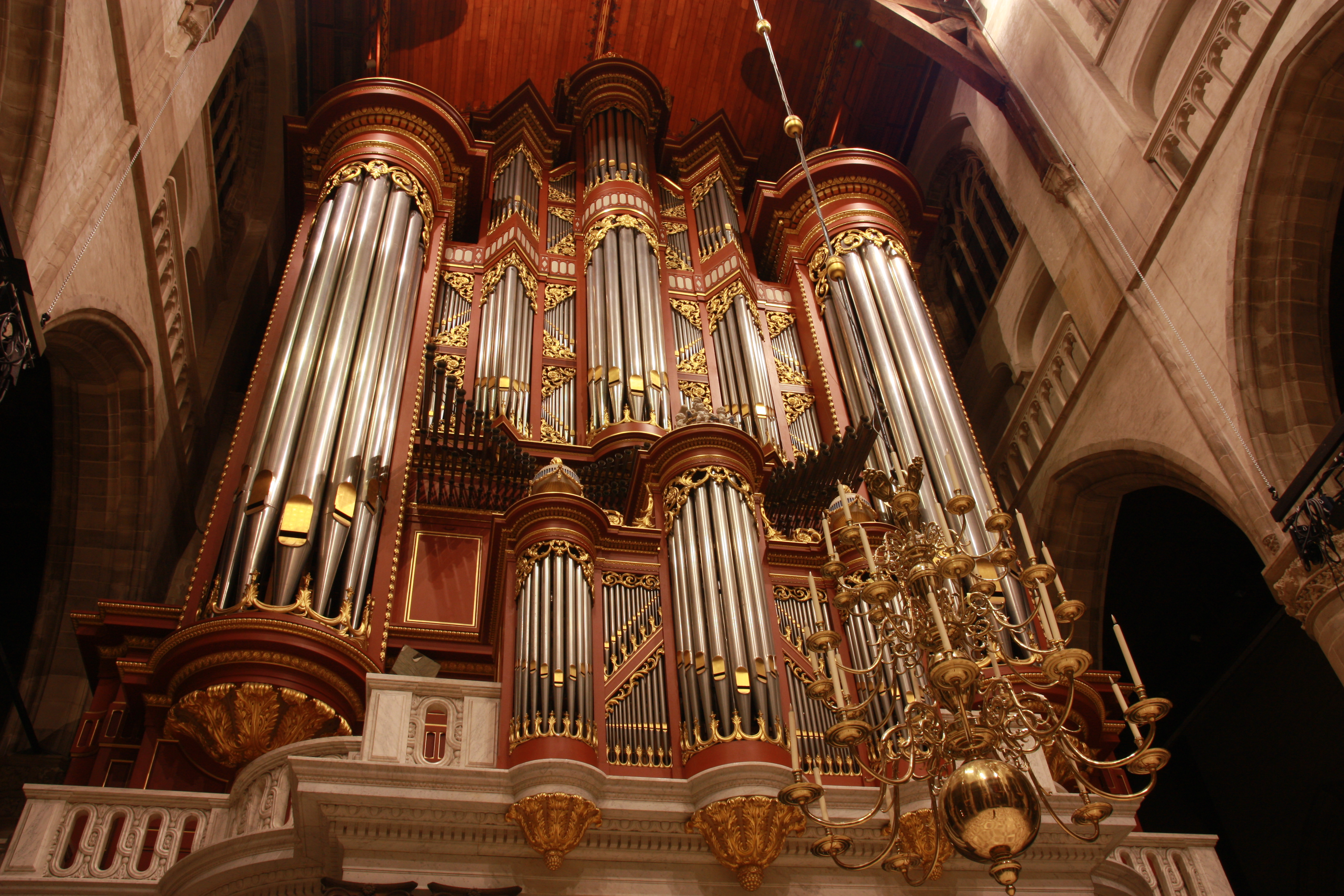Rotterdam, Grote of Saint-Laurenskerk
| Builder | Marcussen & Søn |
|---|---|
| Year | ca. 1973 |
| Period/Style | Modern |
| Stops | 84 |
| Keyboards | 5+P |
| Keyaction | tracker/mechanical |
| Tuning | Equal at 440 Hz |
| Sampleset |
Available
 , sampled by
Sonus Paradisi
, sampled by
Sonus Paradisi
|
The large gothic church of Rotterdam was built in 15th century. The church was completed in 1525. Four hundred years later it was almost destroyed by a German bombardment in May of the year 1940. The interior of the sanctuary was entirely lost due to fire. There were left only the outer walls and a part of the tower. The restoration of the church was done after the World War, between 1947-1968.
The original church had a large 3 manual organ of Hans Goltfuss from 1644, but a new instrument was to replace it in 1790. The work on the new instrument was not finished before 1828 while several organbuilders successively worked on it. In 1845 Bätz enlarged this instrument to arrive at 72 stops. Nevertheless, this instrument was destroyed completely with the church during the war time. The large organ which we can hear in the church today was built by Marcussen & Son in 1973, the organ case was designed by the architect J. W. Besemer. The instrument is based on 32-foot pedal, it consists of six divisions (Rugwerk, Hoofdwerk, Bovenwerk, Borstwerk, Chamadewerk and Pedaal). It is completely mechanical organ with 85 speaking stops and ca. 7600 pipes. It is said to be the largest purely mechanical organ in Europe (by amount of pipes). There is, however, the Barker mechanism to be switched on optionally by a foot lever to help the organist when all the manuals are coupled together. However, the full instrument can be operated without this device very well.
One striking feature of the instrument is its multi-rank Principal stops. Practically all the Principals and Octaves 16', 8', 4' of all the divisions are made of more than one unisono souding ranks. It makes the sound of the Principal chorus considerably wide and deep. The timbre gets characteristically rich what cannot be achieved easily if a conventional single rank Principal stops are used. The Cimbal of the Bovenwerk is remarkable for its neo-baroque composition including a quart and a sext.
The organ was designed to allow the performance of all organ literature. Indeed, the plenitude of stops, the complete set of horizontal reeds, the French type of reeds, strings in a swell box, rich selection of wide scaled mutations, complete Principal pyramid, full range of stops in pedal - it is all one can dream of. Thus, a wide range of organ literature from Renaissance, Baroque, Romanticism up to the modern times can be performed adequately on the instrument.
The original church had a large 3 manual organ of Hans Goltfuss from 1644, but a new instrument was to replace it in 1790. The work on the new instrument was not finished before 1828 while several organbuilders successively worked on it. In 1845 Bätz enlarged this instrument to arrive at 72 stops. Nevertheless, this instrument was destroyed completely with the church during the war time. The large organ which we can hear in the church today was built by Marcussen & Son in 1973, the organ case was designed by the architect J. W. Besemer. The instrument is based on 32-foot pedal, it consists of six divisions (Rugwerk, Hoofdwerk, Bovenwerk, Borstwerk, Chamadewerk and Pedaal). It is completely mechanical organ with 85 speaking stops and ca. 7600 pipes. It is said to be the largest purely mechanical organ in Europe (by amount of pipes). There is, however, the Barker mechanism to be switched on optionally by a foot lever to help the organist when all the manuals are coupled together. However, the full instrument can be operated without this device very well.
One striking feature of the instrument is its multi-rank Principal stops. Practically all the Principals and Octaves 16', 8', 4' of all the divisions are made of more than one unisono souding ranks. It makes the sound of the Principal chorus considerably wide and deep. The timbre gets characteristically rich what cannot be achieved easily if a conventional single rank Principal stops are used. The Cimbal of the Bovenwerk is remarkable for its neo-baroque composition including a quart and a sext.
The organ was designed to allow the performance of all organ literature. Indeed, the plenitude of stops, the complete set of horizontal reeds, the French type of reeds, strings in a swell box, rich selection of wide scaled mutations, complete Principal pyramid, full range of stops in pedal - it is all one can dream of. Thus, a wide range of organ literature from Renaissance, Baroque, Romanticism up to the modern times can be performed adequately on the instrument.
| I Rugwerk | II Hoofdwerk | III Bovenwerk (swell) | IV Borstwerk | III Chamadewerk | Pedaal |
|---|---|---|---|---|---|
| Quintadeen 16' | Praestant 16' | Gedekt 16' | Gedekt 8' | Trompeta magna 16' (desc.) | Praestant 32' |
| Praestant 8' | Octaaf 8' | Praestant 8' | Praestant 4' | Trompeta brillante 8' (bas/desc.) | Octaaf 16' |
| Holpijp 8' | Open fluit 8' | Baarpijp 8' | Blokfluit 4' | Trompeta de batalla 8' (bas/desc.) | Gedekte Quint 10 2/3' |
| Quintadeen 8' | Quint 5 1/3' | Roerfluit 8' | Nasard 2 2/3' | Clarin fuerte 4' (bas/desc.) | Octaaf 8' |
| Octaaf 4' | Octaaf 4' | Viola di Gamba 8' | Octaaf 2' | Clarin 2' (bas) | Gemshoorn 8' |
| Roerfluit 4' | Spitsfluit 4' | Viola di Gamba 8' (beating) | Gedekte fluit 2' | Orlos 8' (bas/desc.) | Roerquint 5 1/3' |
| Quint 2 2/3' | Octaaf 2' | Octaaf 4' | Octaaf 1' | Octaaf 4' | |
| Octaaf 2' | Ruispijp 3-4 st. | Open fluit 4' | Tertiaan 2 st. | Koppelfluit 4' | |
| Woudfluit 2' | Mixtuur 8-10 st. | Terts 3 1/5' | Scherp 4-5 st. | Nachthoorn 2' | |
| Sifflet 1 1/3' | Scherp 6-8 st. | Roerquint 2 2/3' | Regaal 16' | Dwarsfluit 1' | |
| Sesquialter 2-4 st. | Trompet 16' | Nachthoorn 2' | Kromhoorn 8' | Ruispijp 5 st. | |
| Mixtuur 6-8 st. | Trompet 8' | Terts 1 3/5' | Regaal 8' | Cornet 3 st. | |
| Scherp 4-6 st. | Cornet 5 st. | Mixtuur 5-7 st. | Mixtuur 10 st. | ||
| Dulciaan 16' | Cimbel 3 st. | Bazuin 32' | |||
| Trompet 8' | Bombarde 16' | Bazuin 16' | |||
| Kromhoorn 8' | Trompette 8' | Fagot 16' | |||
| Voix humaine 8' | Trompet 8' | ||||
| Clairon 4' | Trompet 4' | ||||
| Zink 2' |
1623438975-Pedro de Araujo Batalla 07062021 Rtdam Hoofd Surr
0:00
0:00
1623438749-Couperin Cromorne 07062021 Rtdam Hoofd Surr
0:00
0:00
1623270254-sortie test rotterdam
0:00
0:00
1623086666-Hauptwerk recording 2021-06-06-14-59-14 Rtdam Hoofd Surr
0:00
0:00
1623159876-BWV 553
0:00
0:00
1623309076-bedard 88 40 32 72
0:00
0:00
https://www.sonusparadisi.cz/en/organs/netherlands/rotterdam-laurenskerk-main-organ.html
 Pipe Organ Map
Pipe Organ Map


